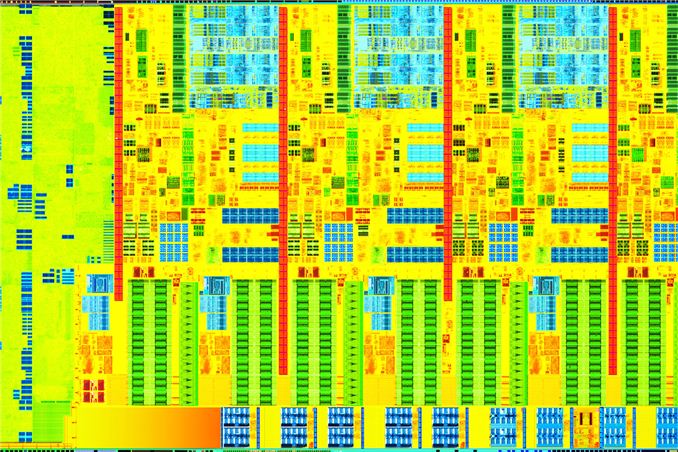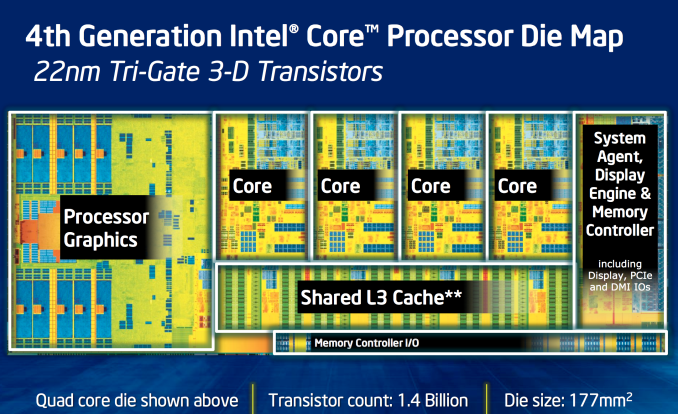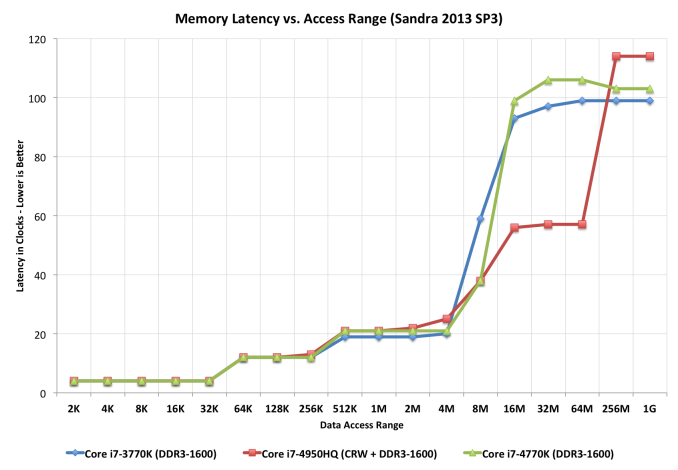The Haswell Review: Intel Core i7-4770K & i5-4670K Tested
by Anand Lal Shimpi on June 1, 2013 10:00 AM EST
This is a very volatile time for Intel. In an ARM-less vacuum, Intel’s Haswell architecture would likely be the most amazing thing to happen to the tech industry in years. In mobile Haswell is slated to bring about the single largest improvement in battery life in Intel history. In graphics, Haswell completely redefines the expectations for processor graphics. There are even some versions that come with an on-package 128MB L4 cache. And on the desktop, Haswell is the epitome of polish and evolution of the Core microprocessor architecture. Everything is better, faster and more efficient.
There’s very little to complain about with Haswell. Sure, the days of insane overclocks without touching voltage knobs are long gone. With any mobile-first, power optimized architecture, any excess frequency at default voltages is viewed as wasted power. So Haswell won’t overclock any better than Ivy Bridge, at least without exotic cooling.
You could also complain that, for a tock, the CPU performance gains aren’t large enough. Intel promised 5 - 15% gains over Ivy Bridge at the same frequencies, and most of my tests agree with that. It’s still forward progress, without substantial increases in power consumption, but it’s not revolutionary. We compare the rest of the industry to Intel’s excellent single threaded performance and generally come away disappointed. The downside to being on the top is that virtually all improvements appear incremental.
The fact of the matter is that the most exciting implementations of Haswell exist outside of the desktop parts. Big gains in battery life, power consumption and even a broadening of the types of form factors the Core family of processors will fit into all apply elsewhere. Over the coming weeks and months we’ll be seeing lots of that, but today, at least in this article, the focus is on the desktop.
Haswell CPU Architecture Recap
Haswell is Intel’s second 22nm microprocessor architecture, a tock in Intel’s nomenclature. I went through a deep dive on Haswell’s Architecture late last year after IDF, but I’ll offer a brief summary here.
At the front end of the pipeline, Haswell improved branch prediction. It’s the execution engine where Intel spent most of its time however. Intel significantly increased the sizes of buffers and datastructures within the CPU core. The out-of-order window grew, to feed an even more parallel set of execution resources.
Intel added two new execution ports (8 vs 6), a first since the introduction of the Core microarchitecture back in 2006.
On the ISA side, Intel added support for AVX2, which includes an FMA operation that considerably increases FP throughput of the machine. With a doubling of peak FP throughput, Intel doubled L1 cache bandwidth to feed the beast. Intel also added support for transactional memory instructions (TSX) on some Haswell SKUs.
The L3 cache is now back on its own power/frequency plane, although most of the time it seems to run in lockstep with the CPU cores. There appears to be a 2 - 3 cycle access penalty as a result of decoupling the L3 cache.


















210 Comments
View All Comments
AmdInside - Sunday, June 2, 2013 - link
I am actually more interested in the new 8 series chipsets than Haswell. I have a Sandybridge work desktop and Ivybridge gaming desktop and would switch my Sandybridge motherboard if the chipset were backwards compatible with SB CPUs.Klimax - Sunday, June 2, 2013 - link
Just reminder: We are more or less out of free performance without new algorithms or massive complexity/power consumption. (There are limits to what we can do)And Intel engineers won't increase complexity of chips. (Otherwise they'd have their own version of GPU problems)
Anyway, waiting for Haswell-E... (Could use AVX2, but don't wont to lose 6 cores of 3930k)
ashetosvlakas - Sunday, June 2, 2013 - link
"As we’ve seen in the past, the K-series parts (and now the R-series as well) omit support for vPro, TXT, VT-d, and SIPP from the list."As this is the official Haswell review and since TSX are not included in the K-series parts, I believe this is a huge omission from the review, especially since transactional memory is a revolutionary technology with a lot of potential. I find the lack of mention misleading and it should be corrected as soon as possible.
KAlmquist - Sunday, June 2, 2013 - link
Thanks for letting us know this. Checking the specifications on ark.intel.com, I find:i5-4430 no TSX
i5-4570 has TSX
i5-4670 has TSX
i5-4670K no TSX
i7-4770 has TSX
i7-4770K no TSX
So TSX is missing from half of the current Haswell models (ignoring the low power S and T chips). So far we only have quad core chips; I expect that TSX will be missing from most of the dual core chips. It doesn't seem that TSX is intended to be used by developers writing general purpose code.
Kougar - Sunday, June 2, 2013 - link
Is 2016 the earliest we will see Haswell-E launch?Buying a 4770K means I'm wasting 33% of the die on a GPU I don't want, and because it's a "K" chip it will also lose VT-d capability. Six-core "K" chips retain VT-d support, but buying SB-E seems silly given Haswell offers much better IPC and single-threaded performance, and later even against IB-E it would feel like paying more for less.
Intel has taken a perpetual 2-year break between updating its high end, so if IB-E launches Q4'13 then it seems Q4'15 would be the earliest Haswell-E will show up?
Charlesm1950 - Sunday, June 2, 2013 - link
Haswell GT3e graphics come at what price? Certainly a lot more than Haswell GT2 or Richland A10 graphics. And Intel is right, Haswell GT3e graphics beats old, entry level discrete graphics cards. BUT, Haswell does not do DUAL GRAPHICS! Pair a Haswell with a dGPU and you get only the graphics horsepower of the dGPU. In short, you waste all that die area that Intel devoted to GT3e and eDRAM. On the other hand, pair a AMD Richland A10 with a dGPU and both GPUs work in tandem to give performance scores well beyond Haswell GT3e and for dare I say a lot less money. That's true even with the cheapest entry level Radeon GPU. So, Intel has created a monster graphics engine and put memory on the die - but to claim its free or the best solution is just being a fan boy for Intel.monohouse - Sunday, June 2, 2013 - link
this my friends, is a joke, the mighty Haswell K models will not support VT-x, LOL this is going to be the first nail in Intel's coffin in favor of AMD, and I bet AMD are going to take advantage of this (and they already take advantage of Intel's "K" marketing strategy - why buy an incredibly expensive Intel "K" model without VT-x support, when you can buy an AMD both unlocked and with VT-x support) (the joke is that a 5-year old Core 2 Duo has more to offer than the latest and greatest Intel parts [it supports VT-x]). I am running a 4300 mhz Wolfdale (Penryn) and an another 3000 mhz Conroe, none of what I see here (and in part due to the lack of VT-x support) from Haswell is of any significant enough value over my current hardware, I would have considered it if I had a Pentium 4, but even then I would rather go to the AMD side, since they present no obstacles.and I still have many functional PCI cards and I am not about to throw them away just because Intel decided not to support them (yet another nail in Intel's coffin) (in my opinion hardware has to comply with the user's wishes, not the other way around).
skrewler2 - Monday, June 3, 2013 - link
Wait, what? The K series doesn't include VT-d support, I don't see anything saying they don't support VT-x.BillyONeal - Monday, June 3, 2013 - link
Your comment doesn't make sense. AMD chips obviously don't have VT-x support; they have a competing standard, AMD-V. The first generation of virtualization extensions didn't make much of a dent in perf. The larger gains came as a result of SLAT which both AMD and Intel added around the Nehalem timeframe.monohouse - Sunday, June 23, 2013 - link
but SLAT is not going to be available on K models because virtualization is disabled ?